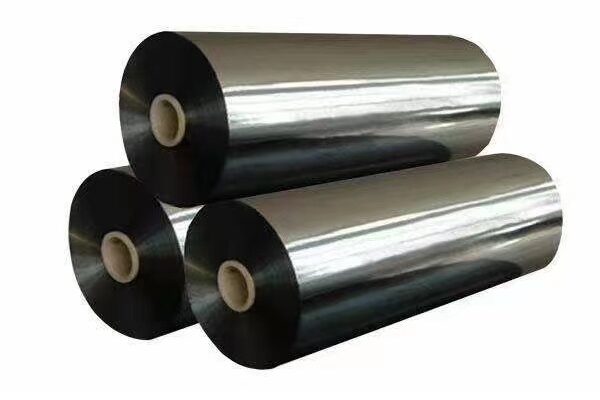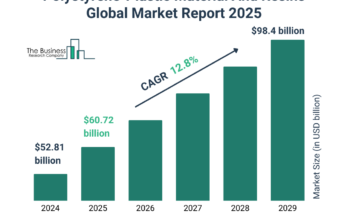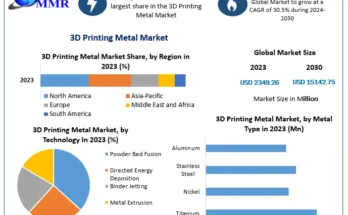Global Metallized Film Market has valued at USD 2.68 billion in 2022 and is anticipated to project robust growth in the forecast period with a CAGR of 5.24% through 2028. Metallized films are polymer films that are coated with a thin layer of metal, typically aluminium. These films possess a glossy metallic appearance reminiscent of aluminium foil. They are known for their cost-effectiveness and find extensive use in decorative applications, food packaging, as well as specialized fields like insulation and electronics. The market for metallized film is projected to experience substantial growth during the forecast period. The rise in the utilization of metallized film across various industries, including food packaging, pharmaceuticals, and electrical sectors, is expected to drive market growth. The application of metallized film in food packaging, thanks to its odor and gas barrier properties, is anticipated to boost demand during the forecast period. Additionally, these films possess electrical properties, such as thermal insulation for cryogenic applications and multilayer insulation film blankets, making them highly suitable for satellite and spacecraft applications. However, the market growth is hindered by the volatility of raw material prices and limited availability of domestic players. Nevertheless, the increased demand for metallized films in aesthetic enhancements to enhance shelf appeal is expected to further drive segment growth.
Key Market Drivers
Growing Use of Metallized Film in Food and Beverage Industry
In recent years, the global metallized film market has experienced a substantial surge in demand, primarily driven by the growing utilization of metallized films in the food and beverage industry. Metallized films, also referred to as metallized plastic films, consist of a thin layer of metal coating applied to a polymer substrate. This innovative packaging solution offers a range of advantages, including enhanced aesthetics, barrier properties, and extended shelf life, making it a preferred choice for manufacturers and consumers alike. Metallized films demonstrate exceptional barrier properties against oxygen, moisture, and UV light, ensuring the preservation of product freshness and quality. This is particularly crucial in the food and beverage industry, where maintaining the integrity of perishable items is of utmost importance. By providing an effective barrier against external elements, metallized films prolong the shelf life of products, reduce food wastage, and preserve the flavor and nutritional content of food and beverages. The global shift towards sustainable packaging solutions has further contributed to the increasing demand for metallized films. Manufacturers are increasingly adopting eco-friendly materials and production processes to align with consumer preferences for environmentally responsible choices. Metallized films offer a sustainable option due to their lightweight nature, which reduces transportation costs and carbon emissions. Moreover, advancements in recycling technologies enable the recovery of valuable materials from metallized films, minimizing their environmental impact. The food and beverage industry’s demand for innovative packaging solutions has compelled manufacturers to develop metallized films with enhanced functionalities. This includes films with advanced sealability, resealability, and compatibility with various packaging formats such as stand-up pouches and flexible sachets. As the food and beverage industry continues to expand, especially with the rise of e-commerce and ready-to-eat products, the demand for effective and visually appealing packaging solutions is expected to increase. Furthermore, emerging markets in Asia-Pacific and Latin America are anticipated to contribute significantly to the growth of the metallized film market, driven by urbanization, changing consumer lifestyles, and increasing disposable incomes.
Growing Demand of Metallized Film in Electronic Industry
Metallized films are renowned for their exceptional properties, including high conductivity, reflectivity, and barrier capabilities. As a result, they play a crucial role in various electronic applications, driving the global metallized film market. These films consist of polymer-based substrates coated with a thin layer of metal, typically aluminum, through vacuum deposition. This metallization process imparts unique characteristics to the film, making it a preferred choice across a wide range of electronic applications. Moreover, metallized films find utility in reflective insulators, mirrors, and holograms due to their high reflectivity properties. Additionally, they exhibit remarkable barrier properties against moisture, gases, and other environmental factors, making them ideal for electronic packaging and encapsulation. The growing trend towards flexible and wearable electronics necessitates materials that can bend, fold, and adapt without compromising performance. Metallized films offer exceptional flexibility while maintaining their electrical and barrier properties, making them suitable for flexible circuitry, displays, and sensors. As electronic components continue to shrink in size, the need for compact, high-performance materials becomes evident. Metallized films, with their thin yet conductive layers, contribute significantly to reducing the size and weight of electronic devices, a crucial factor in modern electronics. Furthermore, they play a role in enhancing energy efficiency through their use in capacitors and batteries, where their high conductivity facilitates rapid charge and discharge cycles. The rise of IoT devices and the proliferation of electronics in various industries have also led to an increased demand for effective and reliable electronic packaging solutions. Metallized films’ barrier properties protect sensitive electronic components from moisture, gases, and external contaminants, thereby extending the lifespan of devices.
Download FREE Sample Report @ https://www.techsciresearch.com/sample-report.aspx?cid=3347
Growing Demand of Metallized Film in Cosmetic and Personal Care Industry
The cosmetic and personal care industry has experienced a significant surge in the use of metallized films, driven by innovation and evolving consumer preferences. Metallized films are produced through a specialized process, involving the deposition of a thin layer of metal, typically aluminum, onto a plastic substrate. This technique results in films with a metallic sheen, enhancing the visual appeal of packaging materials. In the cosmetic and personal care industry, establishing an emotional connection with consumers is crucial, and packaging design plays a vital role in achieving this. Metallized films offer a distinct advantage in this regard, as their reflective surfaces capture and manipulate light, creating a dynamic visual effect that grabs attention and stands out on store shelves. Beyond their visual appeal, metallized films also provide functional benefits that align with the demands of the cosmetic and personal care industry. These films are typically made from materials like polyester (PET), which exhibit resistance to moisture, chemicals, and temperature variations. This resilience ensures that products remain protected from external factors that could compromise their quality. As online shopping continues to rise, packaging needs to not only safeguard products during transit but also deliver an engaging unboxing experience. Metallized films add an element of excitement to this experience. Furthermore, metallized films are lightweight, contributing to reduced shipping costs and a smaller carbon footprint. With sustainability becoming increasingly important to consumers, brands are seeking packaging solutions that are visually striking while remaining environmentally responsible. Metallized films address this demand by offering a balance between aesthetics and ecological consciousness.
Key Market Challenges
Volatility in Prices and Less Availability of Raw Materials
One of the key challenges faced by the global metallized film industry is the consistent volatility in prices. Fluctuations in the prices of raw materials, including polymers, aluminum, and adhesives, are influenced by various factors such as geopolitical events, market demand, production disruptions, and currency fluctuations. These price fluctuations can pose significant risks to manufacturers as sudden spikes can lead to increased production costs, impacting profit margins and overall market competitiveness. The availability of raw materials plays a critical role in the production of metallized films. However, the industry currently faces the challenge of raw material scarcity. This scarcity is primarily driven by factors such as increased global demand, supply chain disruptions due to natural disasters or geopolitical tensions, and the growing focus on sustainability and circular economy practices. The scarcity of raw materials not only affects production capacity but can also result in production delays and increased lead times. As a result, manufacturers may encounter difficulties in meeting order deadlines, potentially leading to customer dissatisfaction and missed market opportunities. To address this challenge, companies in the metallized film market need to explore alternative sources of raw materials, invest in sustainable practices such as recycling and upcycling, and establish robust supply chain partnerships to ensure a steady flow of essential resources.
Key Market Trends
Technological Advancements in Metallization Processes
One of the most significant trends observed in the metallized film market is the integration of nanotechnology into the metallization processes. Nanoscale metal particles are being incorporated into the film’s surface, thus enhancing its barrier properties and durability. These nanoparticles contribute to the creation of a more uniform metal layer, thereby improving both the appearance and functional performance of the film. Advancements in coating technologies have resulted in the development of high-performance metallized films with specialized functionalities. Anti-fog coatings, easy-peel coatings, and heat-sealable coatings are now being seamlessly integrated into metallized films, thereby enhancing their suitability for specific applications. These coatings not only enhance convenience for consumers but also pave the way for packaging innovation. Furthermore, innovations in metallization processes have led to improvements in production efficiency. Adoption of new techniques such as vacuum metallization and sputtering has resulted in faster coating times, reduced energy consumption, and enhanced overall productivity. These advancements not only bring economic benefits but also contribute to the reduction of greenhouse gas emissions.
Segmental Insights
Material Insights
In 2022, the Metallized Film market was dominated by the polypropylene segment and is predicted to continue expanding over the coming years. The market is expected to be driven by the cost-effectiveness of polypropylene metalized films, coupled with the growth of the food and beverage industry. Furthermore, these films find extensive application in the electrical and electronics sector, specifically in communication equipment, timing circuits, and filter networks. These factors serve as the primary drivers for the glass fiber metalized film market.
Related Reports
Plastic Straps Market [2028] – Trends, Share & Forecast
Amphoteric Surfactants Market [2028] – Analysis, Trends, & Insights
Table of Content-Metallized Film Market
- Product Overview
1.1. Market Definition
1.2. Scope of the Market
1.2.1. Markets Covered
1.2.2. Years Considered for Study
1.2.3. Key Market Segmentations
- Research Methodology
2.1. Objective of the Study
2.2. Baseline Methodology
2.3. Key Industry Partners
2.4. Major Association and Secondary Sources
2.5. Forecasting Methodology
2.6. Data Triangulation & Validation
2.7. Assumptions and Limitations
- Executive Summary
3.1. Overview of the Market
3.2. Overview of Key Market Segmentations
3.3. Overview of Key Market Players
3.4. Overview of Key Regions/Countries
3.5. Overview of Market Drivers, Challenges, Trends
- Voice of Customer
- Global Metallized Film Market Outlook
5.1. Market Size & Forecast
5.1.1. By Value
5.2. Market Share & Forecast
5.2.1. By Metal (Aluminium and Others)
5.2.2. By Material (Polypropylene (PP), Polyethylene Terephthalate (PET), and Others)
5.2.3. By End-Use Industry (Packaging, Decorative and Others)
5.2.4. By Region
5.2.5. By Company (2022)
5.3. Market Map
- North America Metallized Film Market Outlook
6.1. Market Size & Forecast
6.1.1. By Value
6.2. Market Share & Forecast
6.2.1. By Metal
6.2.2. By Material
6.2.3. By End-Use Industry
6.2.4. By Country
6.3. North America: Country Analysis
6.3.1. United States Metallized Film Market Outlook
6.3.1.1. Market Size & Forecast
6.3.1.1.1. By Value
6.3.1.2. Market Share & Forecast
6.3.1.2.1. By Metal
6.3.1.2.2. By Material
6.3.1.2.3. By End-Use Industry
6.3.2. Mexico Metallized Film Market Outlook
6.3.2.1. Market Size & Forecast
6.3.2.1.1. By Value
6.3.2.2. Market Share & Forecast
6.3.2.2.1. By Metal
6.3.2.2.2. By Material
6.3.2.2.2. By End-Use Industry
6.3.3. Canada Metallized Film Market Outlook
6.3.3.1. Market Size & Forecast
6.3.3.1.1. By Value
6.3.3.2. Market Share & Forecast
6.3.3.2.1. By Metal
6.3.3.2.2. By Material
6.3.3.2.2. By End-Use Industry
- Europe Metallized Film Market Outlook
7.1. Market Size & Forecast
7.1.1. By Value
7.2. Market Share & Forecast
7.2.1. By Metal
7.2.2. By Material
7.2.3. By End-Use Industry
7.2.4. By Country
7.3 Europe: Country Analysis
7.3.1. France Metallized Film Market Outlook
7.3.1.1. Market Size & Forecast
7.3.1.1.1. By Value
7.3.1.2. Market Share & Forecast
7.3.1.2.1. By Metal
7.3.1.2.2. By Material
7.3.1.2.2. By End-Use Industry
7.3.2. Germany Metallized Film Market Outlook
7.3.2.1. Market Size & Forecast
7.3.2.1.1. By Value
7.3.2.2. Market Share & Forecast
7.3.2.2.1. By Metal
7.3.2.2.2. By Material
7.3.2.2.2. By End-Use Industry
7.3.3. United Kingdom Metallized Film Market Outlook
7.3.3.1. Market Size & Forecast
7.3.3.1.1. By Value
7.3.3.2. Market Share & Forecast
7.3.3.2.1. By Metal
7.3.3.2.2. By Material
7.3.3.2.2. By End-Use Industry
7.3.4. Italy Metallized Film Market Outlook
7.3.4.1. Market Size & Forecast
7.3.4.1.1. By Value
7.3.4.2. Market Share & Forecast
7.3.4.2.1. By Metal
7.3.4.2.2. By Material
7.3.4.2.2. By End-Use Industry
7.3.5. Spain Metallized Film Market Outlook
7.3.5.1. Market Size & Forecast
7.3.5.1.1. By Value
7.3.5.2. Market Share & Forecast
7.3.5.2.1. By Metal
7.3.5.2.2. By Material
7.3.5.2.2. By End-Use Industry



